2011 Week 6
This week, the field school went “beyond the pale.” The expression today has a connotation of unacceptable behavior but in the 17th century, it meant something entirely different. During the Middle Ages in Ireland, the English built a fortified fence around the area claimed by the King. Beyond that was thought of as a wild, uncivilized area. Our move “beyond the pale” was much tamer.
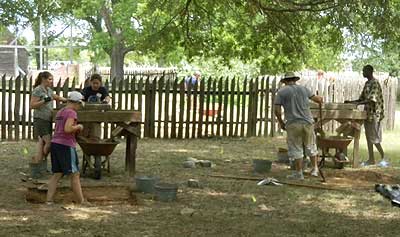
Students excavate units outside the reconstructed fence of the Calvert House site.
The Calvert House site is surrounded by a paling fence, recreating a late 17th-century one found archaeologically. All of our work in the last three years has been within that fence. As we continue to look for fences on the west side of the site, it has become necessary to expand the sample area towards the river, or beyond the pale. So far, the results are not promising – the dirt is hard as concrete, there are few artifacts and features are very hard to see. But, the squares are all in the shade!
Several units have been completed in the midden area, southwest of the house. Interestingly, the midden, or at least some of it, seems to have accumulated in a shallow depression.
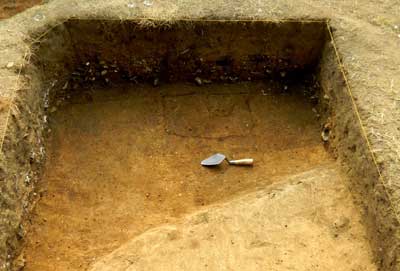
With midden removed from the unit, a fence and post hole became visible.
As always, we are looking for fences and one was found in this unit below the midden. It seems like an early fence, although it is not oriented as most early fences. The reason it seems early is that it has very little material in the fill. Since the midden, a very rich deposit, was directly above it, the lack of debris in the fill suggests that the fence was built and torn down before the midden was deposited. To make sense of the fences, it will be important to use the artifacts to accurately date the midden. In addition to the fence, the photo also shows a post hole adjacent to it, probably a support of the fence.
In previous weeks I mentioned a fence cut by the sewer trench. Excavation of this was completed during the week and the profile at the unit wall is very interesting.
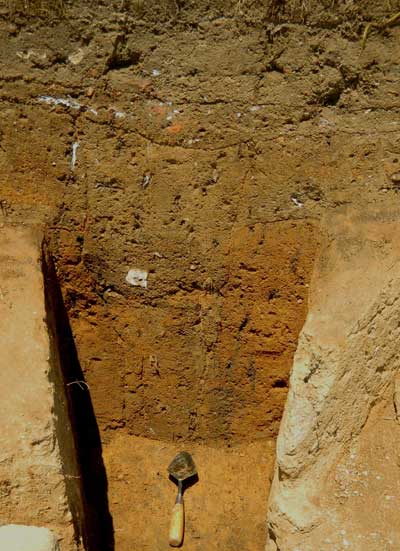
Profile of the deep fence with Calvert House rubble on top.
The bottom of the fence has very little in it, again suggesting that the fence was in place before the midden was deposited. Unlike the previous fence however, the upper portion appears to have been dug out in the 17th-century and filled with debris from the midden. The fence appear to have been removed after the midden had accumulated. This may have been late in the history of the site.
At the top of the profile is a thin lens full of brick and mortar. These materials are most likely rubble from the destruction of the Calvert House. Over most of the site, this layer has been completely destroyed by plowing in the 18th century. It is only preserved here, on top of the fence, because the fill of the earlier feature slumped and the plow could not reach it.
After struggling mightily through the gravel driveway, the cellar has been fully exposed.
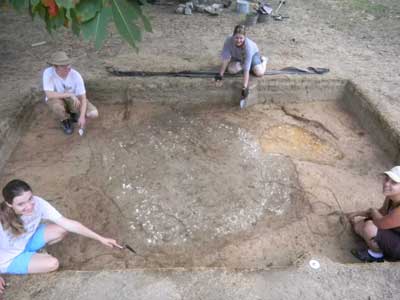
Students Irene Posey, Kyle McGrath, Caitlin Crosby and Lia Rios point to the four corners of the cellar hole.
It is approximately 6.5 ft. by 5.5 ft. and has post holes at three corners. The fourth post hole is likely just out of the excavation area. The cellar hole intrudes the post holes but not the molds, indicating they are likely to be contemporary. What we seem to have is a very small, post-in-the-ground building just big enough to cover the cellar hole. Several interpretations of this feature are possible but the most likely is that this is a dairy or root cellar. It was a place to keep beverages and other food stuffs cool in the summer and warm in the winter. While we were looking for outbuldings like a stable or a kitchen, this is quite a surprise. We may have to do more with the cellar.
This week’s artifact is a glass prunt found in the midden area. A prunt is a glob of decorative glass applied to a larger vessel. This specimen is often termed a raspberry prunt because of its bumpy surface. Most often seen on a large drinking glass, called a Roemer, these were both decorative and practical. In an era with different standards of hygiene, where greasy food was often eaten with the fingers, the slick surface of a glass was an invitation to disaster. Prunts not only made the glass look better, they provided a grip for greasy fingers.
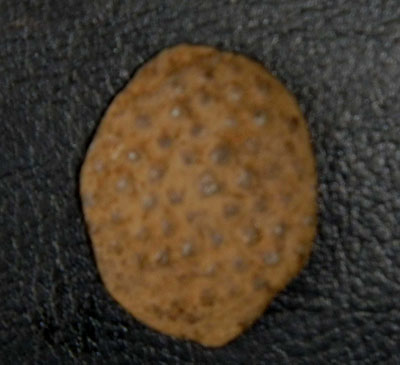
A glass prunt found in the Calvert House midden


